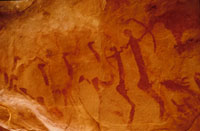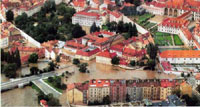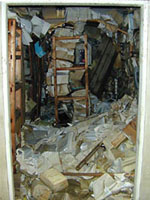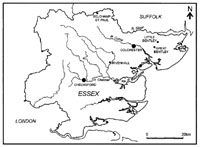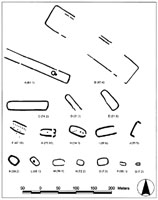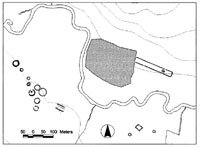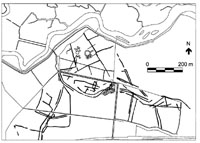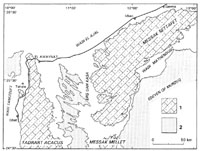
Figure 1. Southwest Libya, showing
the main focus of the Society's Libya tour, from Germa (top right)
to the Tadrart Acacus mountains (bottom left), then east across
the Erg Uan Kasa sand sea and along the southern edge of the Messak
Settafet to Wadi Mathendusch, and back to Germa. |
The Society's
2002 Study Tour was to Libya, specifically to see the rich archaeology
of the province of Fezzan in the southwest, deep in the Sahara (Figure
1). When I first proposed the Libya trip to Council a few years ago
I had no idea I would be the Society's President when it finally came
to fruition, but I always hoped to be part of such a tour. Although
I have worked extensively in Libya, I have never been to the far southwest
to see the wonderful rock art there, the rock paintings of the Tadrart
Acacus mountains and the rock engravings of the Messak Settafet plateau,
which were to be the highlights of the tour. The other reason I proposed
the tour was that my Leicester colleague David Mattingly was running
a large multi-period survey and excavation project (the Fezzan Project:
Mattingly, 2000), so it seemed an ideal opportunity to use his expertise!
David and I were the lecturers on the trip, with Dr Isobel Sjöström
(an experienced Saharan archaeologist who has worked on a number of
Libyan and Sudanese field projects) the Andante Representative. The
student place was awarded to Michael Rainsbury, who has just completed
a Masters in Prehistoric Rock Art at Durham (and who has strict orders
to write something for PAST in due course!). We gathered at Heathrow
in the wee small hours of Monday 14 October, and by the afternoon, via
Amsterdam, we were all in the Libyan capital Tripoli. We were very ably
looked after in Libya by Abdul Heba, the Representative of Winzrik Tourism
Services, the local travel company who were working with Andante on
the tour arrangements. We walked round Tripoli's Medina (Old City) in
the falling light, and everybody was taking sweet minted Libyan tea
in the shadow of the Old Castle (Tripoli's finest historic monument,
now housing the National Museum and the Department of Antiquities) as
the muezzin called out through the dusk - we had thoroughly arrived.
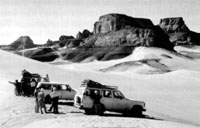
Figure 2. The summit of the
Takhakhouri Pass in the Tadrart Acacus. |
The overarching
theme of the study tour was the transition from foraging to farming
in the Sahara, with the tour arranged in chronological reverse order.
On the morning of the second day we flew south to Sebha, the capital
town of Fezzan, where our party was divided between five battered Toyota
Landcruisers, and we spent the rest of the day working our way southwest
down the Wadi el Ajal oasis visiting Garamantian sites investigated
by David's project. The Garamantes were a remarkably complex state-organised
society that controlled Fezzan in classical times, trading variously
with the Punic and Roman world to the north, the Egyptians to the east,
and the Sahel peoples on the southern side of the Sahara. David showed
us round his major excavations of the ancient city of Germa, the Garamantian
capital, where he has exposed a continuous stratigraphic sequence from
c.500 BC to the present day. We also looked at Garamantian tombs (there
are estimated to be over 100,000 down the wadi), and foggaras, the underground
water channels once thought to be Islamic in date but which his project
has shown convincingly were in fact a Garamantian technology, the basis
of the intensive oasis farming that sustained their state. In the falling
light we scrambled over the hilltop fortress of Zinchecra a few kilometres
from Germa, where excavations by Charles Daniels in the 1960s revealed
evidence for complex protohistoric sedentary societies, the beginnings
of the Garamantian state system, c.1000-500 BC. That evening we slept
in a hostel belonging to Winzrik, where we also picked up our camping
gear and the kitchen truck that was to accompany us on the desert trip.
The final member of the party was a charming member of the Libyan security
services (one accompanies every tourist group), who had never been into
Fezzan before and turned out to be the keenest tourist of all of us.
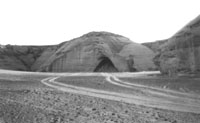 Figure 3. Uan Afuda cave.
Figure 3. Uan Afuda cave. |
On the morning
of the third day we travelled into the Ubari sand sea on the northern
side of the Wadi el Ajal oasis to visit some extraordinary relict lakes
there which the Fezzan Project has shown were foci of settlement for
Mesolithic foragers and Neolithic forager-herders. This visit also introduced
the party to the way you have to drive across sand dunes: charge full
tilt (slipping back down if you don't make the top) but crucially manage
to stop on the crest, so you can see whether you can get down the other
side without taking off if the slope on the far side turns out to be
vertical. We managed to visit some spectacular mudbrick Garamantian
pyramid tombs under restoration by the Department of Antiquities, before
setting off on the long road journey southwest towards the desert settlement
of El Uwaynat near the Algerian border at the top of the Tadrart Acacus
mountains, where we were meant to be heading off road. However, we had
some long delays from bad punctures to the kitchen truck, and we eventually
made our first camp in the dark in a bowl in the sand dunes (our drivers
always chose these, to be out of the wind). With some trepidation I
watched some well-known Society members reading by the light of the
car headlights their instructions about how to assemble the new tents
they had been given. There were anguished cries of 'I haven't done this
for 20/30/40/50/60 years! [tick number of years as appropriate!]
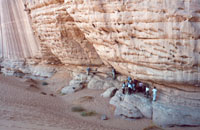
Figure 4. Society members examining
rock art in the Wadi Teshuinat (Tadrart Acacus). |
We almost had
a major logistic crisis the next day, because there turned out to be
no petrol in El Uwaynat and our desert journey needed all the vehicle
tanks full as well as the dozen or so jerry cans we also carried. Abdul
and the security agent even tried the local army garrison, but got a
dusty answer. The previous petrol station was 200 kilometres back, but
the word on the Al-Uwaynat street (it only has one) was that there 'probably
was' petrol 100 kilometres further south in Ghat, the last settlement
before the Algerian and Niger borders. So we kept on down the asphalt
road to Ghat, and - eventually - there was. We also filled up with water
here - we could really only carry what we needed for drinking and cooking,
so we all had to get used to washing with less than a pint of water
per day per person. By detouring to Ghat we were on the western side
of the Tadrart Acacus mountains, whereas the archaeology is all on the
eastern side, so we had to make a long detour south as far as the border
zone with Algeria, then cross the spectacular Takhakhouri Pass (Figure
2), the vehicles repeatedly having to gain height up every incline crawling
through slushy 'fesh-fesh' sand, and falling back repeatedly, before
finally making the summit.
The Tadrart Acacus
has been the focus of research by Italian scholars over many decades,
the rock art studies being pioneering especially by Fabrizio Mori (1960,
1965). More recently this work has been augmented by some outstanding
inter-disciplinary survey and excavation programmes, most recently by
Mauro Cremaschi and Salvino di Lernia in and around the Wadi Teshuinat
(Cremaschi and di Lernia, 1998). The traditional theory about the transition
from foraging to herding in the Sahara has been that Neolithic colonists
spread westwards from the Nile valley c.4000 BC, bringing pottery, domestic
animals and plants with them, but the Italian work, especially in the
Wadi Teshuinat that was the main focus of our visit to the Tadrart Acacus,
demonstrates a very different scenario, of Mesolithic foragers changing
to herding in the context of desiccation (Barker 2002, in press).
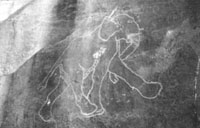
Figure 5. A handsome engraving
of an elephant, a typical example of the 'Bubaline' or 'Big Game'
style of rock art in the Tadrart Acacus thought to have been carved
by early Holocene foragers. |
Their palaeoenvironmental
studies have shown how the region (as elsewhere in the Sahara) was ultra-arid
in the late Pleistocene, and effectively uninhabited, but the transition
to the Holocene introduced conditions dramatically wetter than today
- rainfall has been estimated variously at 10-15 times modern levels
- allowing people to colonize the region once more. On the evidence
of excavations in caves such as Uan Afuda, one of the highlights of
our visit (Figure 3), these early Holocene foragers collected grasses
and wild cereals (sorghum and millet), fished, and hunted riverine animals
including crocodile, hippopotamus and turtle and savanna animals such
as large and small antelopes, though the main quarry was the Barbary
sheep. At Uan Afuda di Lernia and Cremaschi have also found extraordinary
evidence for the management of the latter species 1000 years before
the appearance of domestic cattle, sheep and goats. Their evidence is
very convincing: they found clear structural and micromorphological
evidence for stalling, and the Barbary sheep coprolites have partially-ground
grass seeds in them. This remarkable evidence for 'pre-herding herding'
at Uan Afuda coincides with climatic evidence for a sudden onset of
dryness, so the onset of desiccation appears to have been the context
for significant shifts in behaviour.
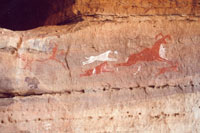
Figure 6. Hunting a Barbary
sheep - a typical example of Saharan 'Pastoral Neolithic' rock
art in the Wadi Teshuinat. |
There is evidence
of a wetter oscillation in the mid Holocene, but the overall trend was
to aridity, which seems to have been the critical context in which the
indigenous populations developed an increasing commitment to pastoralism.
We visited one of the best known 'Pastoral Neolithic' sites in the Sahara,
Uan Muhuggiag (a few kilometres from Uan Afuda), where excavations by
Mori showed that people were herding domestic cattle, sheep and goats
by the fifth millennium BC, combining pastoralism with hunting, fishing,
and gathering. The site is also notable because Mori found fragments
of painted rock that had fallen from painted images on the walls of
the rock shelter into occupation deposits below dated to about 3000
BC. This association is still one of the best pieces of dating evidence
we have for Saharan 'pastoralist' rock art. The Wadi Teshuinat has examples
(in the hundreds) of all the main styles of Saharan rock art, which
is either engraved/incised into the rock, or painted in reds and whites
(Figure 4). Engravings of big isolated wild animals like elephant (Figure
5), giraffe, rhinoceros, buffalo, and crocodile (the so-called Big Game
or Bubaline phase) are assumed to have been carved by hunters in the
early Holocene humid phase. At the other end of the sequence are painted
images of people using horses, chariots, and camels, and recognisable
signs of Egyptian-type culture, generally thought to be of Garamantian
date. In between is the rest of the art, consisting of carvings and
especially paintings of herding and hunting scenes made by the forager-herder
peoples of the Sahara between c.5000 and 1000 BC. They clearly are 'scenes',
too, like the Wadi Teshuinat image of a Barbary sheep being pursued
by dogs and hunters (Figure 6).
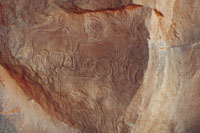
Figure 7. An engraved scene
of a herd of cattle, typical of Saharan 'Pastoral Neolithic' rock
art in the Wadi Mathendusc. |
From the Tadrart
Acacus we travelled eastwards across the Erg Uan Kasa sand sea (another
desert campsite) and then crossed the Messak Settafet, a featureless
rock-strewn upland covered in tyre-puncturing rubble and - in enormous
profusion - prehistoric stone tools (we had ten punctures in the total
trip, in fact). The Messak Settafet is cut by numerous wadi channels,
most of which contain examples of engraved rock art, but the main focus
of our visit was the best known and most spectacular collection, in
the Wadi Mathendusc. The Messak was part of the seasonal grazing schedule
of Neolithic pastoralists, who carved hunting and herding scenes on
major exposed rock faces quite unlike the rather secretive locations
of the Tadradt Acacus paintings. On our last two days in Fezzan we saw
fine carvings of herds of cattle (Figure 7) and sheep, including milking
scenes, and of wild animals like ostriches and giraffes being caught
in enclosures or trapped with thongs attached to heavy rocks - hundreds
of these 'trapping stones' still litter the Messak.
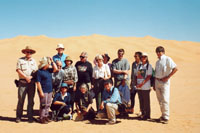
Figure 8. The Society's intrepid
Libya Study Tour group. Our principal lecturer David Mattingly
is in the front row on the right. |
Visiting the
National Museum (opened specially for us) on the last morning before
the flight home, it was clear how much of the best of Libya's desert
archaeology we had managed to pack into our short week. We saw wonderful
archaeology that is still visited by very few Europeans, and spectacular
and varied desert scenery. We crossed some of the most demanding vehicle
terrain in the world, which even with all the support of modern technology
is still very challenging. The Society's members (Figure 8) proved wonderfully
intrepid campers and travellers, and delightful companions. Our Libyan
guides and drivers were enormous fun as well as doing everything to
keep us safe, always totally at ease in what was a very alien environment
to most of our group. (Well versed in European sensitivities, our lead
driver carefully slaughtered and gutted our last night's supper out
of sight behind his vehicle at the final desert camp. And that was after
we had thrashed around the desert in darkness for a couple of hours
looking for the kitchen truck that had set up camp behind the wrong
sand dune!) I am sure I speak for all the Society's members on this
memorable Study Tour that it was a privilege to be in their desert,
in their company.
Graeme Barker,
University of Leicester,
(President, Prehistoric Society)
 |
gba@le.ac.uk |
Reference
Barker, G., 2002, in press, 'Transitions to farming and pastoralism
in North Africa', in C. Renfrew and K. Boyd (eds) Examining the
Farming/Language Dispersal Hypothesis, Cambridge, McDonald Institute.
Cremaschi, M., and di Lernia, S., 1998, eds, Wadi Teshuinat: Palaeoenvironment
and Prehistory in South-western Fezzan (Libyan Sahara), Florence,
Insegna del Giglio.
Mattingly, D., 2000, 'Twelve thousand years of human adaptation in
Fezzan (Libyan Sahara), in G. Barker and D. Gilbertson, eds, The
Archaeology of Drylands: Living at the Margin, London, Routledge,
One World Archaeology 39, pp. 160-79.
Mori, F., 1960, Arte Preistorica del Sahara Libico, Rome, De
Luca.
Mori, F., 1965, Tadrart Acacus, Turin, Einaudi.
|








